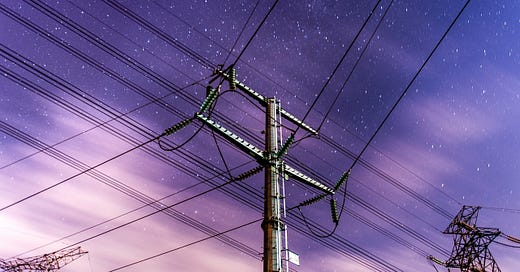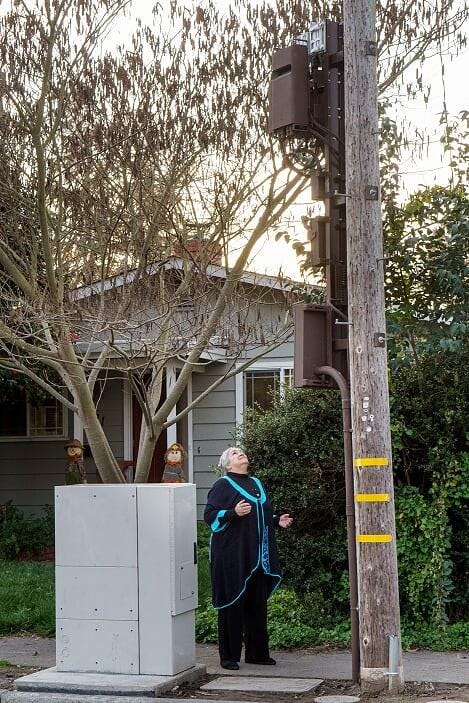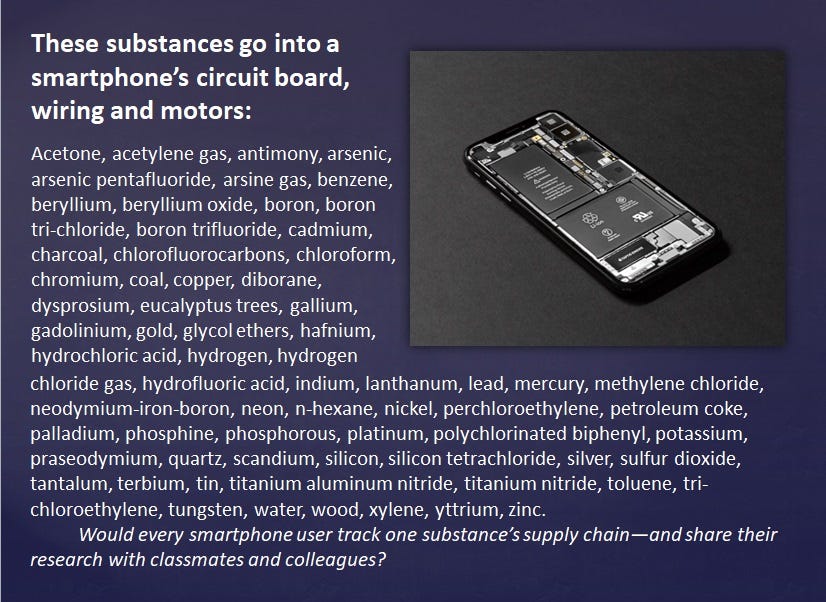A parent who wants to reduce electromagnetic radiation emissions at her children’s school asked me for studies that prove that wireless Internet access uses more electricity than wired. She’d like to show school administrators that wired access lowers electricity bills.
I consider getting wired web access a worthy endeavor: it limits the Internet’s availability to desktops. This encourages living—as our species did until about twenty years ago—without a constant electronic interface.
Reduced Internet access reduces production of devices and infrastructure, which leads to less mining, less energy produced and consumed, less water consumed and polluted by the technosphere, less hazardous waste.
Limited Internet access encourages conversation between nearby humans, growing vegetables, mapping your neighborhood, caring for elderly neighbors, staging a puppet show and other pleasures.
Plus, yes, wired access reduces exposure to microwave radiation.
Does it lower one school’s electricity bills?
It might. But, as an engineer explained to me, looking only at my monthly utility bill is like weighing an elephant by the tip of its tail. Why not explore the global costs of electricity and Internet access? In a school, each class could map and report on the different supply chains and infrastructure behind our screens. Utility bills don’t show the costs of the power grid, access networks, data storage centers or manufacturing devices and infrastructure. But we sure pay for them.
The power grid
For starters, is your utility publicly or privately owned? What kind of fuel does it use, and where does the fuel come from? How much power does your school use in cold months? In warm months? Besides Internet access, what does your school use electricity for?
Besides fuel, utilities also need generators, power lines, substations, transformers, meter readers, accountants and engineers who maintain voltage control. What percentage of your utility bill goes to fuel? What percentage goes to maintaining infrastructure?
If your school or utility uses (intermittent) solar PVs or industrial wind power, what goes into manufacturing the solar PVs or wind turbines? Does backup (during cloudy or windless days) come from batteries or another fuel source?
Data storage centers
Now to Internet access. When you research or shop online, read social media, check your bank records or stream videos, you’re accessing the data center nearest you. Some data storage centers can be seen from outer space. From floor-to-ceiling, they’re filled with computers—and cooling systems that keep the computers from overheating. They take up land, guzzle water and electricity.
The more data transmitted and stored, the more energy required. Since one second of video can contain 30 to 60 still images, streaming a video takes much more energy than downloading a photo, which requires more data (and therefore more energy) than transmitting voice, which takes more data and energy than text. One hundred text-only reports make up less than 9 megabytes (MBs) of data. One eight-minute video can take 30 MBs.
The International Energy Agency estimates that data centers consumed 220-330 Terawatt hours in 2021. The state of California uses around 278 TWhs per year.
Partly because of AI (which can require ten times the computing costs of standard Internet searches), U.S. data center demands will more than double by 2030.
Where’s the data storage center nearest your school? How much electricity does it use?
Access networks
Doing anything online—as well as texting or phoning with a mobile device—depends on local access networks.
Dr. Tim Schoechle, an international communications, energy, engineering and policy consultant and the author of Reinventing Wires, explains that “an access network starts with fiber optics, telecommunications’ fastest and cheapest data delivery system. Data rides on fiber ‘wires’ from a provider’s main hub to public rights-of-way (PROWs) such as utility poles. Fiber optics cables get buried underground, strung on utility poles and laid in the ocean. They provide the Internet’s ‘backbone’ in large public areas, for businesses with multiple buildings, for school campuses. Public funds support this (very expensive) buildout.”
Typically, telecom corporations provide the wireless (and profitable) “last mile” or last 100 feet from the PROW to the end-user. Wireless infrastructure is an addition to basic telecom infrastructure; it consumes about ten times as much energy as fiber optics. This is largely because of the power demanded by radio transmitters at every wireless cell site.
Of course, satellites demand yet more power.
“When fiber is delivered to a building or a home,” Schoechle continued, “the cable goes through a wall and connects to a little black box inside. This doesn’t use much power. An Ethernet cable then connects the box to a small wired (or wireless) router or hub (for multiple connections)—and then to your computer. Then, that’s it—you’ve got wired Internet access.”
Ethernet cables continue to improve in speed and decreased cost.
“If the cable at the wall connects to a wireless (Wi-Fi) router,” Schoechle explains, “then Internet access (and microwave radiation) will spray all over your house or building, slow the data rate—and demand much more energy than a wired system.”
Mobile phones, he added, “can operate on a cellular access network or on household Wi-Fi, which usually provides better phone quality.”
Then, 3G uses 15 times more energy than wired access. 4G consumes 23 times more energy than wired access. (Corcoran-2012; Huang-2013) Miguel Coma has written that 5G might be wonderful for private networks within a factory, say; but it’s unnecessary for public networks.
Does your school provide wired or wireless Internet access?
Manufacturing, one substance at a time
Of course, there’s no Internet access without a computer. Mass production of laptops, smartphones, desktops, printers, iPods—etcetera—requires mining, fossil-fuel-powered smelters, toxic chemicals, assembly plants, and an intercontinental network of fossil fuel-dependent ships, planes and airports, trains and rails, and trucks and roads.
Take silicon. Fiber optics transfer data by sending pulses of light on electronic-grade silicon. Transistors—the basic building blocks of every computer—are made with pure silicon. To manufacture it, extract quartz and a pure carbon (i.e., petroleum coke from the Tar Sands) and harvest dense wood. Ship these three things to a smelter kept at 3000 degrees Fahrenheit by natural gas, coal, nuclear and/or hydropower. (A smelter cannot operate with solar PVs or industrial wind power since these provide intermittent power; and unreliable power can blow up a smelter.) Silicon used by fiber optics, transistors and solar panel wafers actually requires several more energy-intensive, toxic-waste-emitting, water-guzzling steps to reach necessary purity.
Silicon is just one substance used by fiber optics and computers.
Would every student map the supply chain of one substance in their wired or mobile computer—and share their research with classmates?
Could students also research how to reduce our global digital footprint—and school utility bills? How/can we educate ourselves to think globally, locally and personally about energy use and technology?
Studies (not hyperlinked) about digital energy consumption
Baliga, Jayant, et al., “Energy Consumption in Wired and Wireless Access Networks,” IEEE Communications Magazine, June, 2011.
Centre for Energy Efficient Telecommunications (CEET), Bell Labs and University of Melbourne, “The Power of Wireless Cloud: An analysis of the energy consumption of wireless cloud,” April 2013.
Corcoran, Peter, “Emerging trends in electricity consumption for consumer ICT,” 2013.
DeDecker, Kris, “Why We Need a Speed Limit for the Internet,”
https://www.lowtechmagazine.com
Huang, Junxian, “A close examination of performance and power characteristics of 4G LTE networks,” June 2012.
Koomey, Jonathan, “Separating Fact from Fiction: A challenge for the media,” IEEE Consumer Electronics Magazine, January, 2014. Koomey, a research fellow for energy policy and finance at Stanford, responds to Mark Mills’ claim (explained in The Cloud Begins with Coal, below) that the iPhone uses as much electricity as two refrigerators when you count the energy needed to make it, run it and power the “behind-the-wall” equipment to deliver data.
Mills, Mark P., The Cloud Begins with Coal: Big Data, Big Networks, Big Infrastructure and Big Power: An Overview of the Electricity Used by the Global Digital Ecosystem, Sponsored by the National Mining Association and the American Coalition for Clean Coal Electricity, 2013.
Mills, Mark P., Digital Cathedrals, Encounter Books, 2019.
Singer, Katie, “Digital Enlightenment: An invitation,” 2023.
Troszak, Thomas, “The hidden costs of solar photovoltaic power,” NATO ENSEC COE, 2021. Troszak’s description of manufacturing silicon for solar panels applies to manufacturing electronic-grade silicon.
Mapping Our Technosphere
Last, I’m still fundraising to finish Mapping Our Technosphere. The book illuminates the supply chains that make the Internet possible. Introduced by the late Jerry Mander, it includes Miguel Coma’s reports about why 5G is great for private-factory networks—and unnecessary for public networks. It challenges users to trace the supply chain of one substance in a computer; it challenges engineers to make biodegradable computers. The book needs $15,000 for rare images’ copyright permits; for editing, design, website expenses…and to keep its author fed and sheltered. Can you help this book get to the printer? Ecological Options Network, my fiscal sponsor, can take donations of $500 or more. Please address your check to EON, and write “Katie Singer book project” in the memo area. Address the envelope to Mary Beth Brangan, EON Co-Director, POB 1047, Bolinas, CA 94924.
Smaller (still much appreciated!) donations can go through PayPal or directly to me, at PO Box 6574 Santa Fe, NM 87502 USA.
Or, sign up for a paid subscription to this substack!








